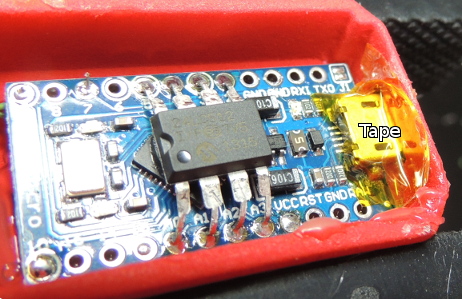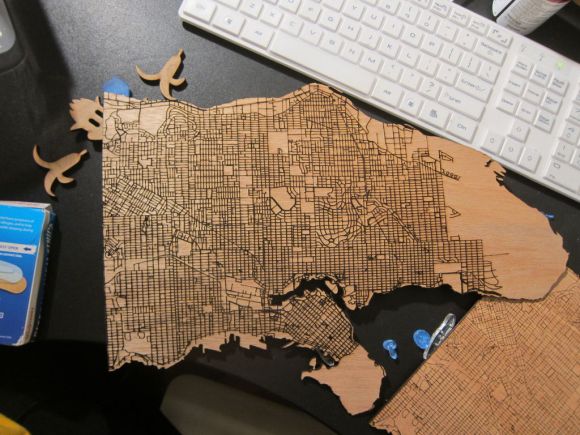Building A Final Key

Remembering passwords is a pain, and there’s a number of devices out there to make it easier. If you’re looking to roll your own, this guide to building a Final Key will walk you through the process.
We talked about the Final Key before. It’s a one button password manager that encrypts and stores your password. It acts as a virtual serial port for configuration. When you hit the button, it becomes a keyboard and types in the correct password.
The creator has no intentions of making this a commercial project for a number of reasons. Instead, easy build instructions are provided based on the Arduino Pro Micro. The 24LC512 EEPROM can be soldered directly to the Arduino by bending out the DIP legs. A few resistors, a button, and an LED finish off the project. The last step is to fill it with hot glue to prevent tampering.
The Final Key firmware is available on Github, and the case can be ordered from Shapeways. If you’re interested in hardware password management, you can also check out the Mooltipass which is being developed on Hackaday.
[Thanks to Lars for the tip!]
Sci-Fi Contest Roundup: The Valve Universe

While most of the entries to our Sci-Fi contest come from movies and TV shows, a select few are based on the Valve universe, including a few builds based on Portal and Team Fortress 2.
Deadly neurotoxin
Who wouldn’t want a gigantic articulated sociopathic robot hanging around? Two groups are building a clone of GLaDOs from the Portal series. and already the builds look really great.
[AmarOk], developed an open-source personal assistant called RORI that intends to be a more helpful version of GLaDOs, without all the testing and killing. He, along with [Peterb0y] and [n0m1s] are turning this personal assistant software into a GLaDOs replica.
Taking a slightly different tack, [Eric] and [jjyacovelli] built a GLaDOs-like robot with a camera in the ‘face’. This camera connects to a Google Glass and tracks the user’s head movements. There’s also a Nerf gun attached to the end of the robot body, triggered by double winking. Yep, it’s a heads-up display GLaDOs, perfect for punishing your test subjects.
Heavy load comin’ through!

Not to be out done by a malevolent, hyper-intelligent artificial intelligence, [Tyler] and [Ryan] are building the cutest gat’ dern weapon in all of west Texas. It’s the level one sentry from Team Fortress 2, and the guys are turning one into a paintball sentry.
The TF2 sentry is a cute little bugger capable of motion tracking and perimeter defense, filling enemies with lead should they ever come too close.
While the end result probably won’t be as large or as heavy as the “official” real-life turret, a smaller table-top sized model is probably a little more practical. Even if it doesn’t live up to expectations, upgrading the sentry is simply a matter of whacking it with a wrench a few times.
There’s still time for you to cobble together an awesome Sci-Fi project and have a chance to win some awesome prizes.
Rebuilding A Custom IC Saves HP Pulse Generator
 [Matthew] got himself into a real pickle. It all started when he was troubleshooting a broken Hewlett Packard 8007A pulse generator. While trying to desolder one of the integrated circuits, [Matthew] accidentally cracked it. Unfortunately, the chip was a custom HP Pulse shaper IC – not an easy part to source by any means. That broken chip began a 5 year mission: to explore strange new repair methods. To seek out new life for that HP 8007A. To boldy fix what no one had fixed before.
[Matthew] got himself into a real pickle. It all started when he was troubleshooting a broken Hewlett Packard 8007A pulse generator. While trying to desolder one of the integrated circuits, [Matthew] accidentally cracked it. Unfortunately, the chip was a custom HP Pulse shaper IC – not an easy part to source by any means. That broken chip began a 5 year mission: to explore strange new repair methods. To seek out new life for that HP 8007A. To boldy fix what no one had fixed before.
[Matthew’s] first repair attempt was to build a drop in replacement for the HP chip. He took a look at the block diagram, and realized the chip was just some simple logic gates. He built his version with a small PCB and Fairchild TinyLogic gates. Unfortunately, the TinyLogic series is fast CMOS, while HP’s original chip used Emitter-coupled Logic (ECL). Thanks to the wildly different voltage levels of the two logic families, this design had no chance of working.
Five years later, [Matthew] was going to school at MIT, and had access to a wire bonding machine. He rebuilt the package using some epoxy, and managed to re-run the various bond wires. While everything looked promising, this attempt was also a failure. After all that work, the chip was blown.
Continue reading “Rebuilding A Custom IC Saves HP Pulse Generator”
Sniping 2.4GHz
A long time ago when WiFi and Bluetooth were new and ‘wardriving’ was still a word, a few guys put a big antenna on a rifle and brought it to DefCon. Times have changed, technology has improved, and now [Hunter] has built his own improved version.
The original sniper Yagi was a simple device with a 2.4 GHz directional antenna taped onto the barrel, but without any real computational power. Now that displays, ARM boards, and the software to put this project all together are cheap and readily available, [Hunter] looked towards ubiquitous computing platforms to make his Sniper Yagi a little more useful.
This version uses a high gain (25dBi) antenna, a slick fold-out screen, and a Raspberry Pi loaded up with Raspberry Pwn, the pentesting Raspi distro, to run the gun. There’s a button connected to the trigger that will automatically search the WiFi spectrum for the best candidate for cracking and… get cracking.
[Hunter] says he hasn’t taken this highly modified airsoft rifle outside, nor has he pointed out a window. This leaves us with the question of how he’s actually testing it, but at least it looks really, really cool.
Developed On Hackaday: Vote For Your Favorite Card Art
A few weeks ago we asked our dear readers if they were interested in coming up with some card art for the Mooltipass project. We received more than a dozen of them and a few days ago the HaD project Mooltipass followers/Mooltipas Google group recipients voted for their favorite ones.
Today we’ll present you the three popular ones and ask you to pick your favorite, so please follow us after the break…
Continue reading “Developed On Hackaday: Vote For Your Favorite Card Art”
Using Public Data To Make Laser Cut Maps

If you have access to a laser cutter you’re going to want to take a look at this brilliant tutorial. [Steven Smethurst] has figured out how to extract public map data and turn it into a file ready to be laser cut onto your choice of material.
In his example he’s using Vancouver’s Open Data Catalog to build his map using the coastal and public street data. To do this he’s using a program called TileMill which you can get for free from MapBox — it’s a great piece of software for designing your own interactive maps — and the best part is, you can import data from a wide variety of sources, such as Vancouver’s Open Data!
You can import the shape (.SHP) files from the Open Data Catalog and add them as layers into TileMill. From there you can manipulate your map, adjust the detail, and then import as a .SVG or .DXF file ready for laser cutting.
In addition to the Instructable on how to do this, he’s also recorded an in-depth video tutorial which you can check out after the break.













